

Embera Indians
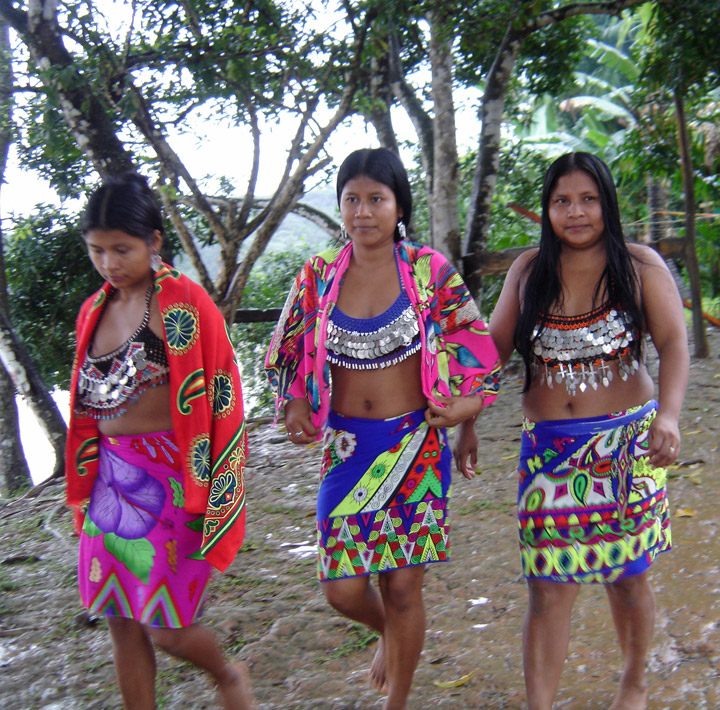
Embera
The Embera and Wounaan are two distinct indigenous groups that inhabit eastern Panama and northwestern Colombia.
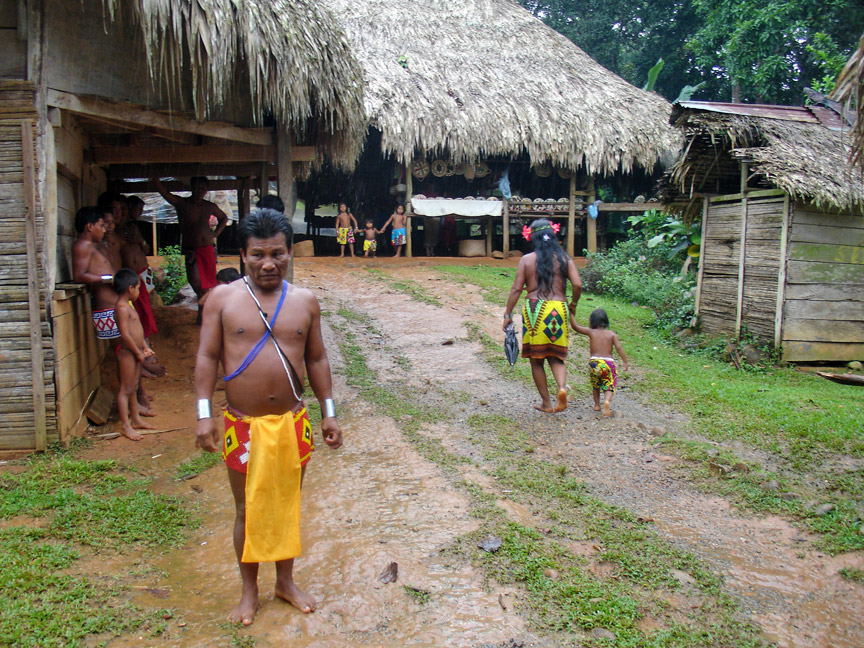
Welcome to the village
The two different groups were formerly and widely known by the name "Chocos", "Chocoe" or "Choco-Indians" because of their autochthonous origins in the Pacific coastal Province of Choco in northwestern Colombia.
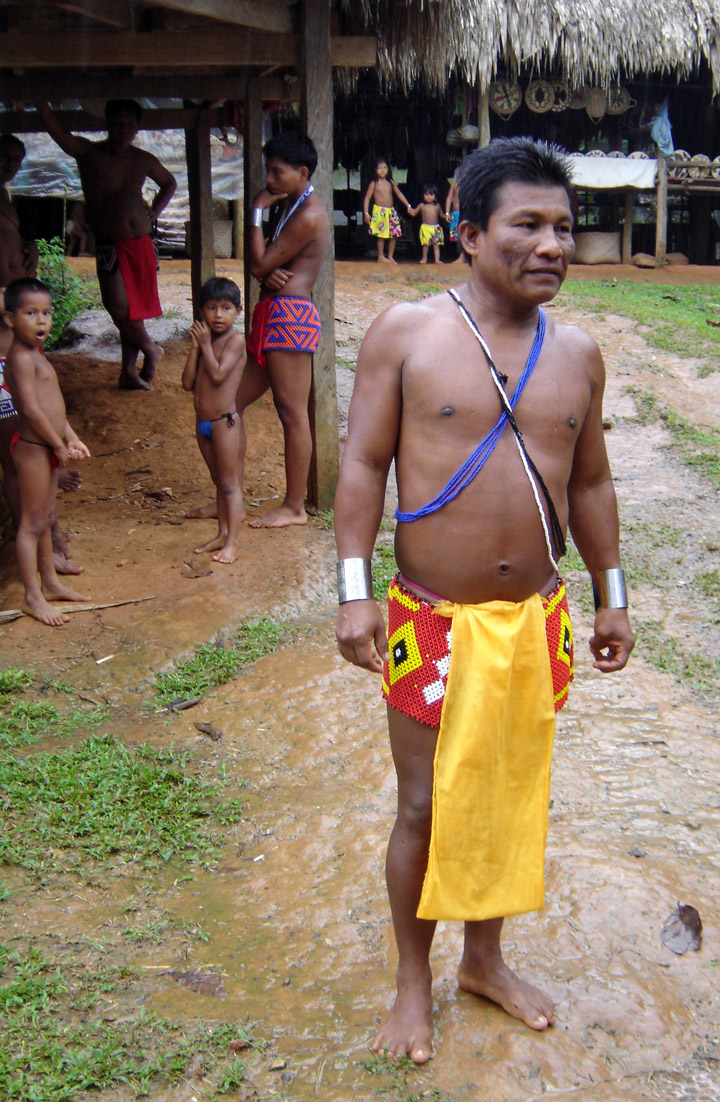
They live in small isolated native villages mostly in the Darién Province of
Panama along the Pacific coast opposite the Pearl Islands, and along the many
tributary watercourses of numerous rivers, including the Chucunaque, Sambu,
Tuira, Jaque, Balsas, and Sabana Rivers; and along the tributaries of the San
Juan River in Colombia.

musicians
Due to the natives' ubiquitous presence in an otherwise lightly populated jungle wilderness, as well as their cultural similarity, late nineteenth century Colombian anthropologists lumped the two cultures under the common rubric of "Chocoe". That inadvertent scientific error has caused substantial confusion about the two distinct groups for nearly 150 years. While linguistically their native languages may contain up to 30 percent cognates, the spoken languages are mutually unintelligible to indigenous Wounaan and Embera. It is estimated that the two languages diverged approximately 800 to 1200 years ago. Their similarity is roughly equivalent to modern English and German.
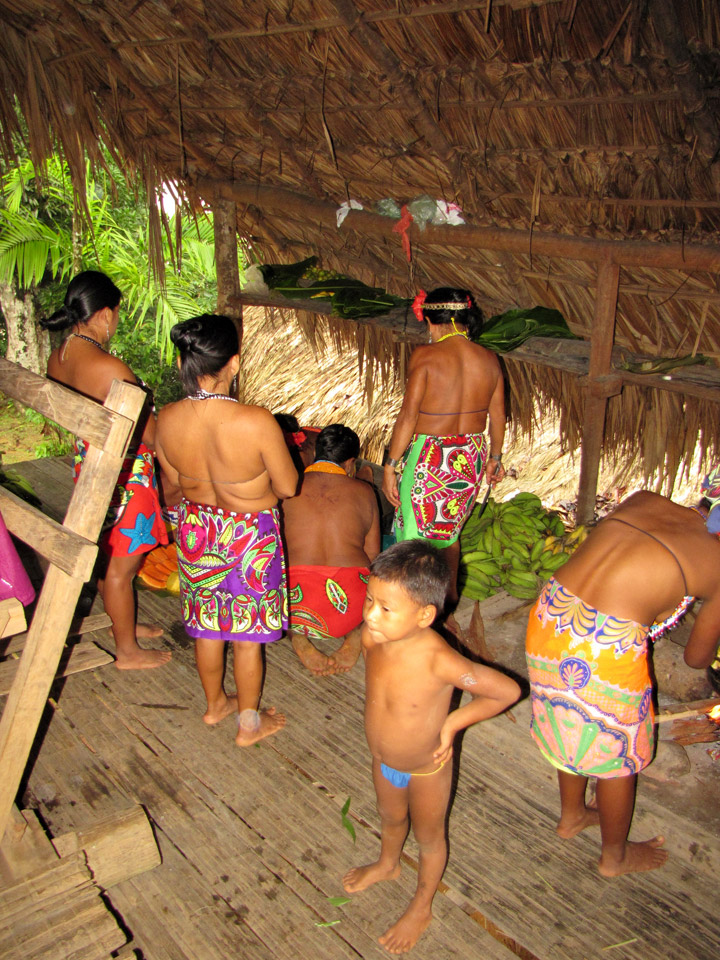
Panamanian census counts estimate that there may be around 9,000 Wounaan and
22,000 Embera in that country. Population numbers in Colombia reportedly may
exceed those numbers for both groups.
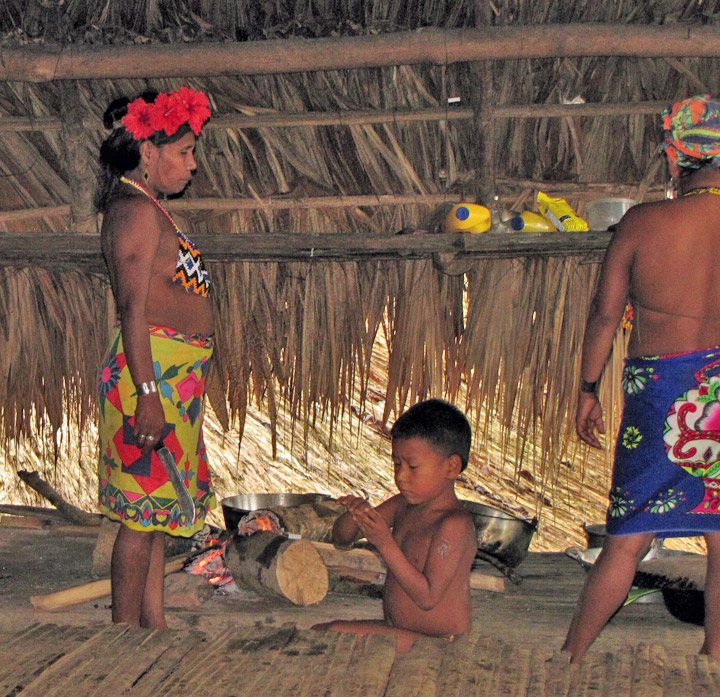
Note: Waounan and Embera people have long shared the same territory and their
recent history and present culture is similar, so this general information shall
serve for both groups. This is not to downplay the distinctions of the two, for
they speak separate languages, their traditional roles --Waounan were artists,
and Embera warriors--set them apart and they are organized politically as
separate groups.
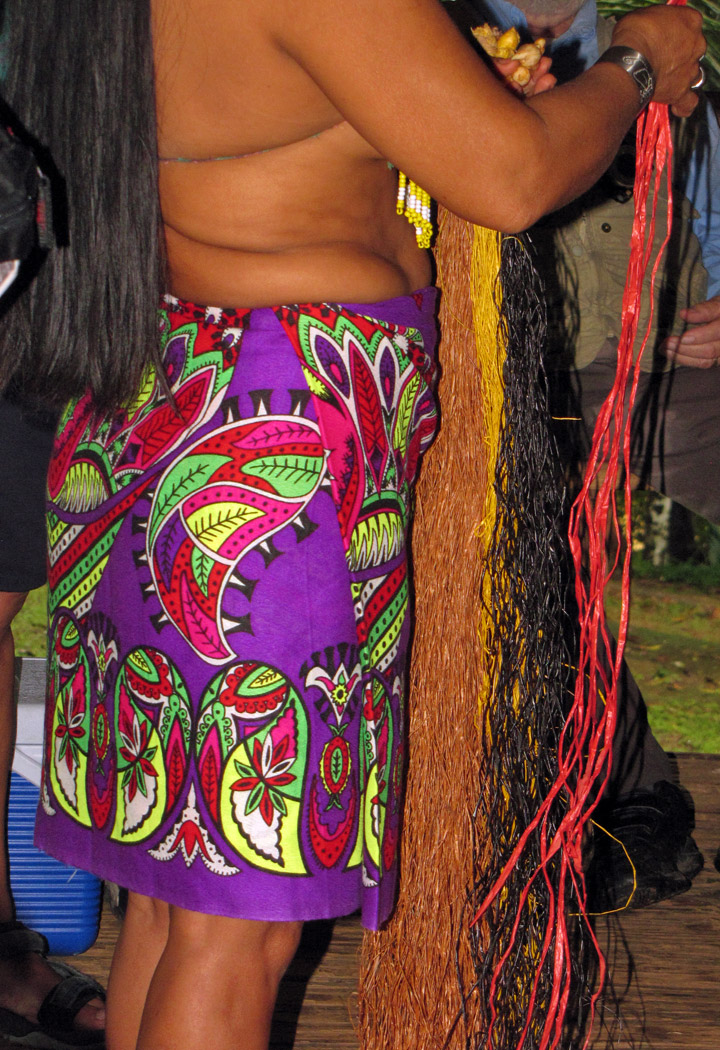
They are short. Women wear colorful cloths from the waist down with flowers on
their heads and necklaces and men wear loincloths. Loincloth (Guayuco in Waounan,
Taparabo in Spanish) and bead necklaces.
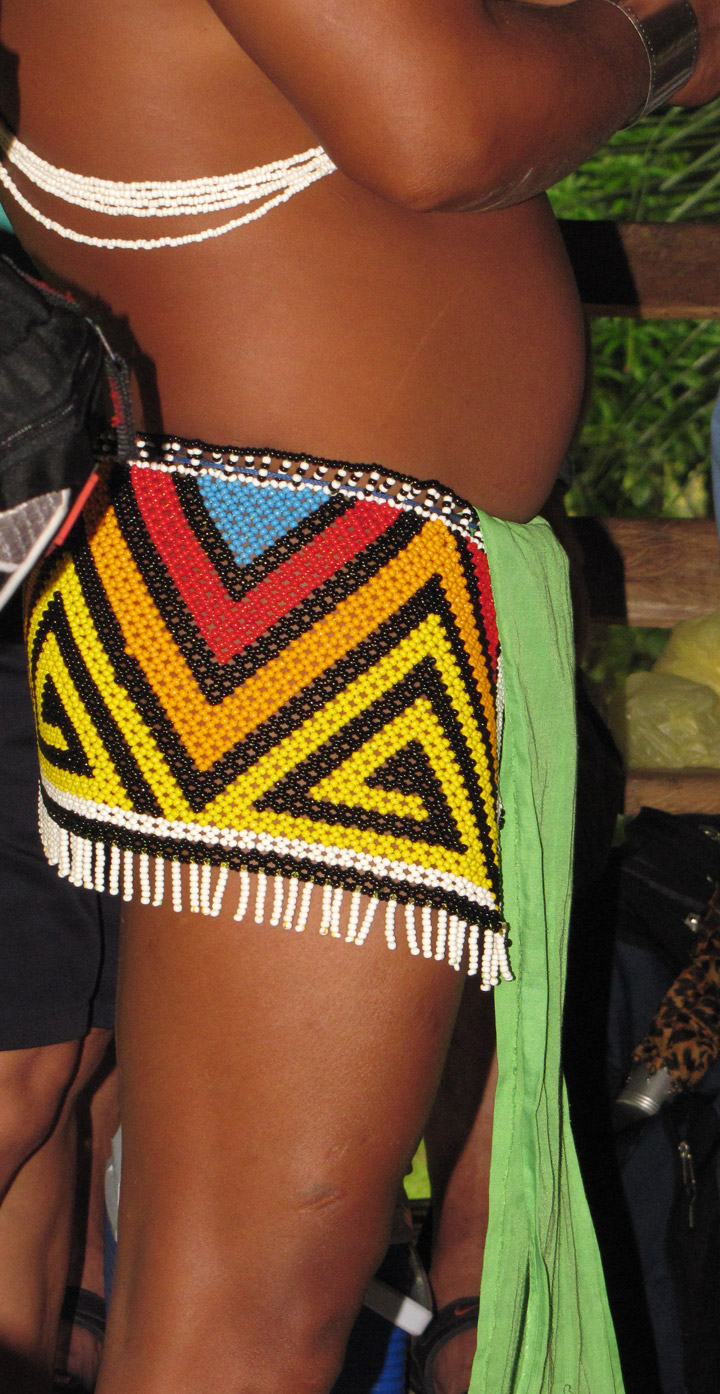
For trekking in the jungle, many indigenous men around the world choose to wear
a loincloth which only covers the genitals. It's simplicity has long been
likened to primitivism by missionaries and westerners when in fact it is a very
practical piece of clothing for tropical jungle environments. Pants and long
shirts soaked with mud and water are heavy and burdensome and they facilitate
skin problems such as rashes and infections. The loincloth or taparabo as it is
known in Panama, is still worn regularly by a few elders and on special
occasions by most male villagers. The Waounan people call them guayuco and
Embera call it anelia. Due to influence from the church and modern Latino
society, most villagers have traded their loincloths for pants or shorts.
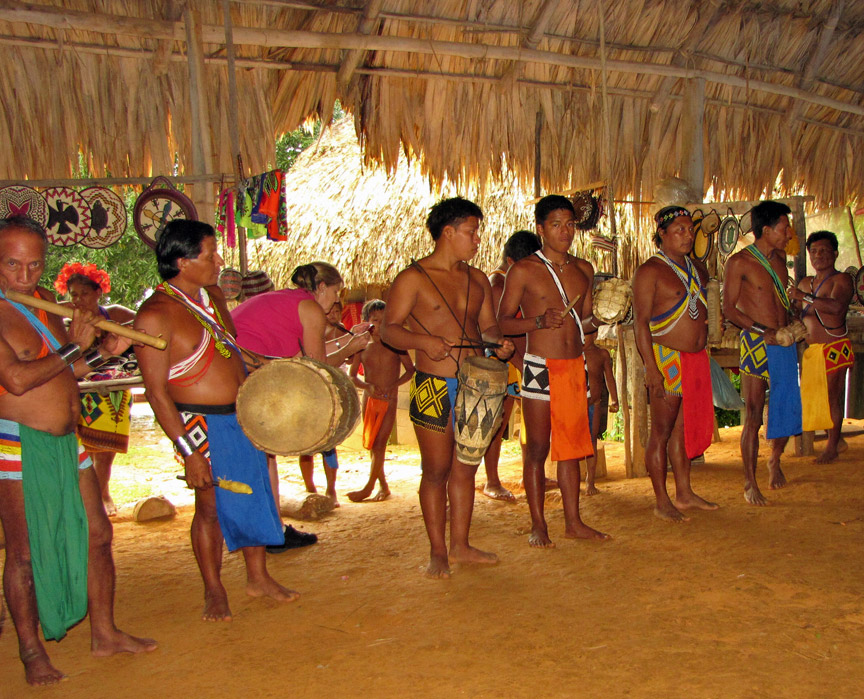
Many people still walk barefoot in the bush but some prefer to wear sandals.
Shoes or sandals are a must when leaving the village to visit neighbors or to go
to the Capital. In some villages, old people still wear their loincloths, and
more recently villages with a desire to revive their cultures and attract
tourism have restarted to wear a loincloths made of colorful cotton. Some men
enjoy wearing on their bare chests bandoliers of plastic beads, but the real
trademark of both Wounan and Embera culture is ebony body painting done with the
juice of the jagua fruit.
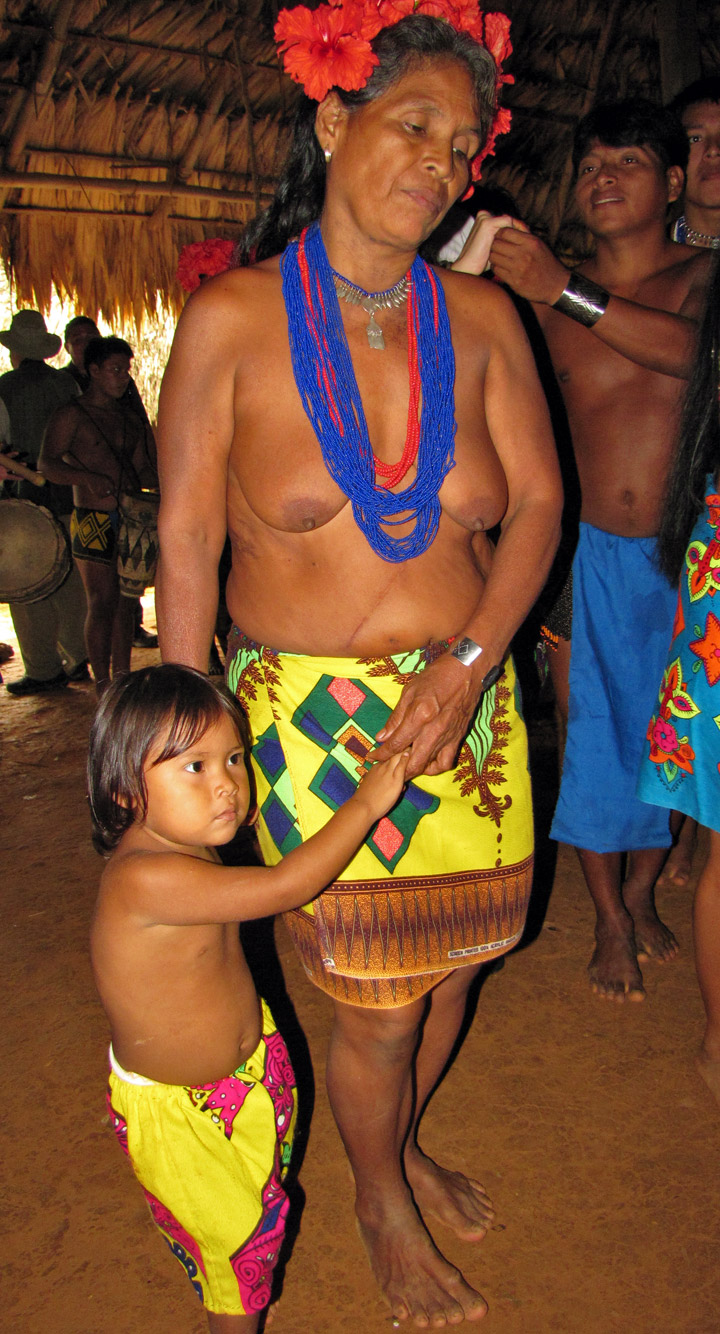
Women are usually bare-chested, wearing only a skirt they call paloma (Uhua in
Embera). Originally their skirt was made with palm fibers, today dyed cotton
fabrics are purchased in Panama were they are usually imported from South-East
Asia. Women, like men, used to cover their bodies regularly with the black dyes
of jagua, a practice still used for ceremonies. They cover their chests with
intricate plastic bead necklaces and ornamental collars made with dozens of
coins. Women also like to add a bit of red color on their faces with the natural
dye of achiote. Recently lipstick and rouge have replaced achiote.
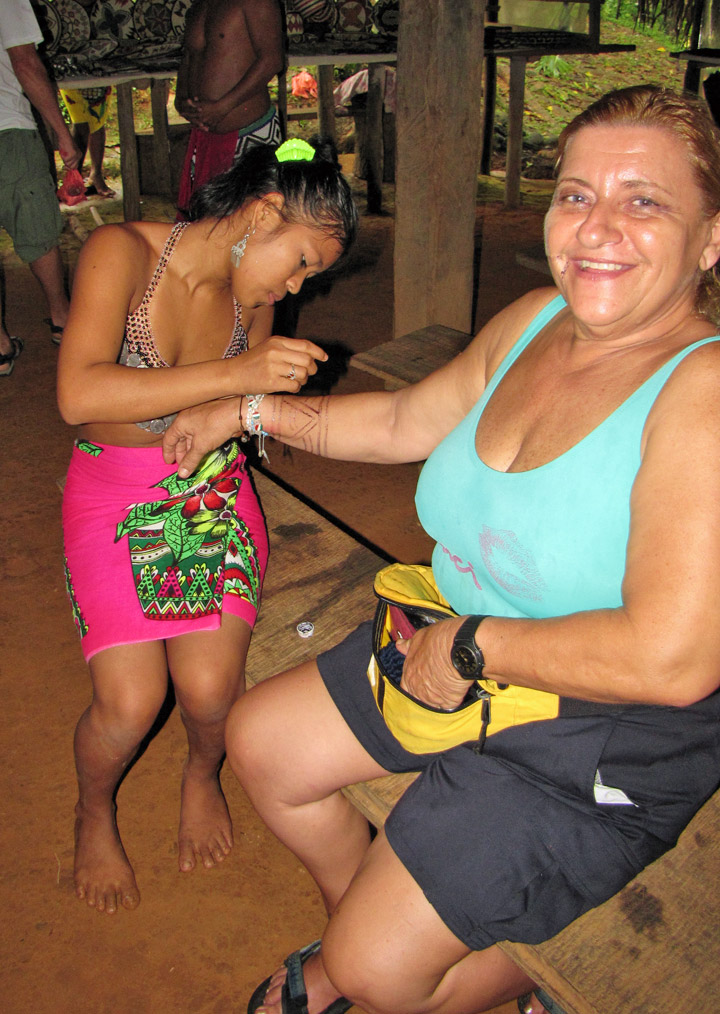
jagua body painting
Jagua is an important fruit in the life of Embera and Waounan people. It is used as a black dye to paint people's skins. The pigment remains embedded in the skin until the external layer is naturally exfoliated, generally lasting between 10 to 12 days. It is indelible dark blue or black, like a two-week tattoo. The jagua body painting is still in use for all celebrations and is one of the most enduring and important customs for both Waounan and Embera people.
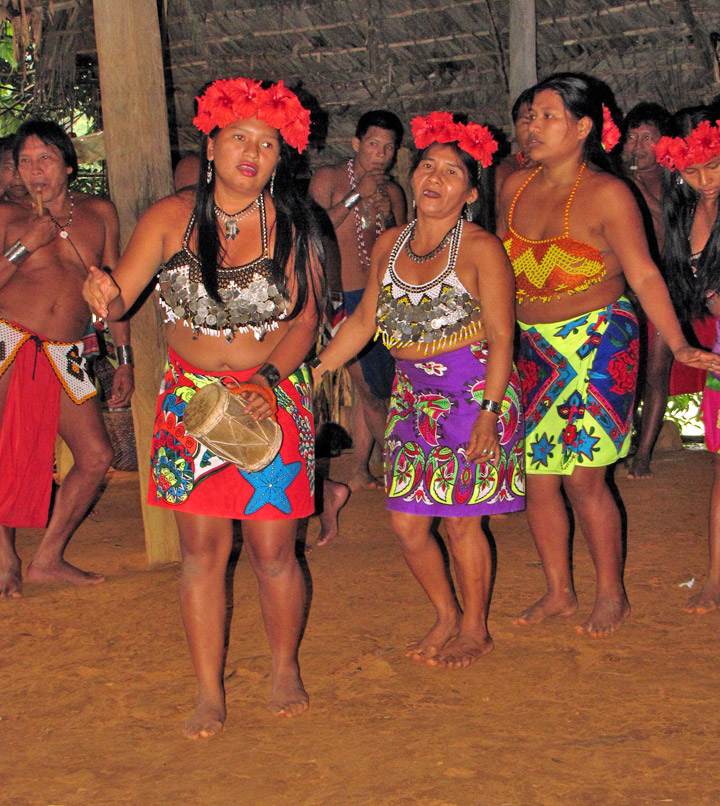
Both men and women practice body painting with the jagua fruit. Some people
cover nearly their full body. Even the lower half of the face covered from a
line extending back from the corners of the mouth. Some designs are solid blocks
of painting with small patches of skin left open to show contrast. Others are
elaborate patterns drawn with delicate lines by artists with the thin tip of a
bamboo stick. Each design has its own meaning and each age group and gender are
assigned specific ones.
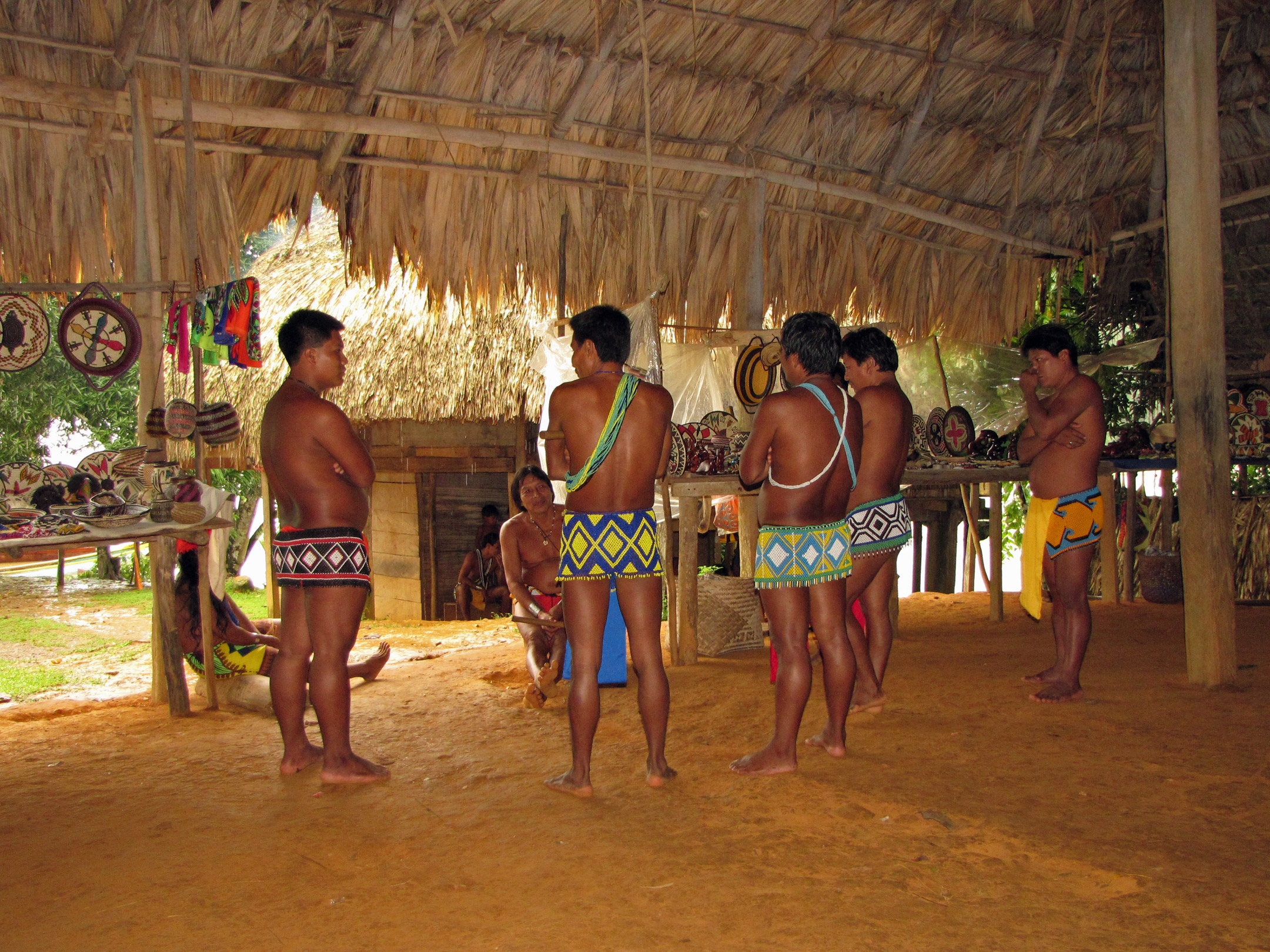
Waounan and Embera people make wide use of silver or gold jewelry. Most common
are wide bracelets and arm and ankle bands. For special celebrations and dances
women will wear heavy necklaces made from coins hung from and woven into a
lattice of string. For regular use, both men and women will wear more simple
necklaces crafted of metal from melted coins
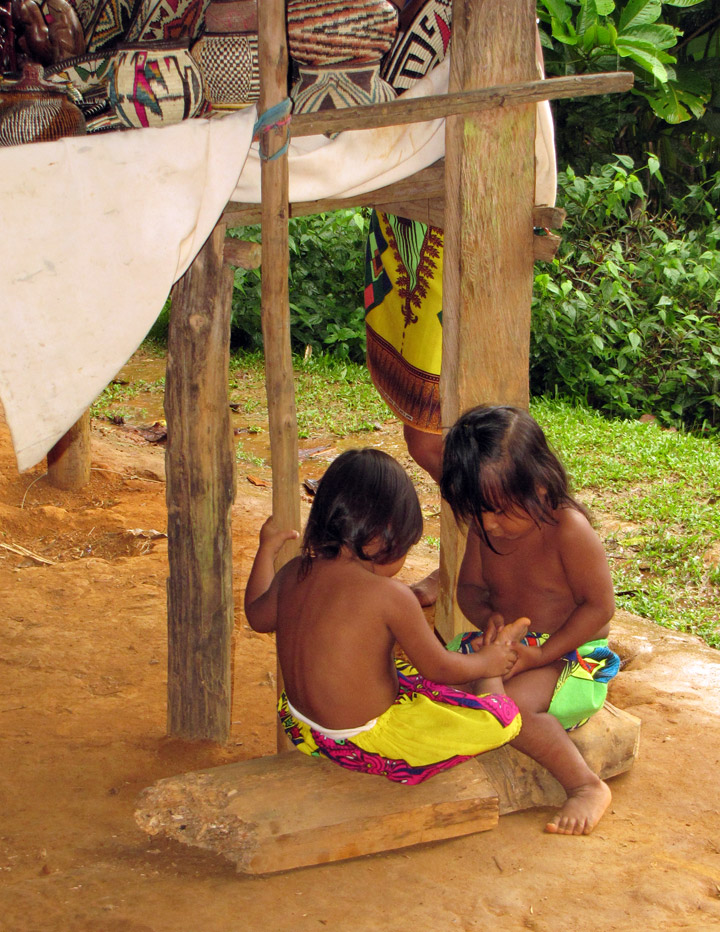
foot check
Originally semi-nomadic forest dweller the Embera and Waounan were known as
hunter-gatherers. They hunted with blowpipes and poisonous darts--a technique
still in practice in Colombia--bows and arrows and long spears. In addition to
hunting, people also set traps for rodents and birds. The most common targets
for hunters were deer, wild boar, coati-mundi, gneke, etc.

A significant part of the diet came from the collection of jungle plants,
fruits, heart of palm, roots and tubers.
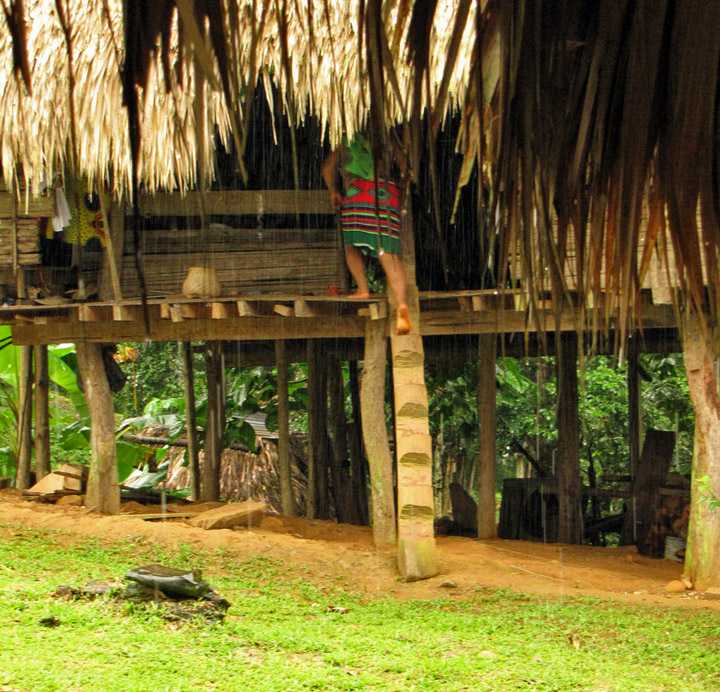
house built on stilts
Houses were traditionally built very high on stilts, up to ten feet. At those heights the house was protected from wild animals such as the feared jaguar called locally tigre (tiger), wild boar, rodents etc. It also offered protection from flooding and even from other people. Houses today are still built on stilts but not as high (the threat of invaders and jaguars is less of a concern), just a few feet of the ground to avoid the flooding of the rainy season and to prohibit the invasion of the insects that nest and congregate in the grasses. People climb into their house using a log in which they carve small steps.

fire pit
Traditional houses are composed of a single room with the fire pit at one end and living space at the other. One or two sides are closed with walls of bamboo or other wood. Walls offer some privacy but by leaving half of the house open, breezes serve to cool the house and keep insects from congregating. The roofs are made of thatch. Schools in most villages have been built by the government and their concrete structures are a striking contrast to the thatched-roofed organic feel of the houses of the village. Each village has its casa communal used for official meetings, to receive guests, or for ceremonies. Traditionally communal houses were crowned with large round, sloping roofs and are by far the largest structure in the village.
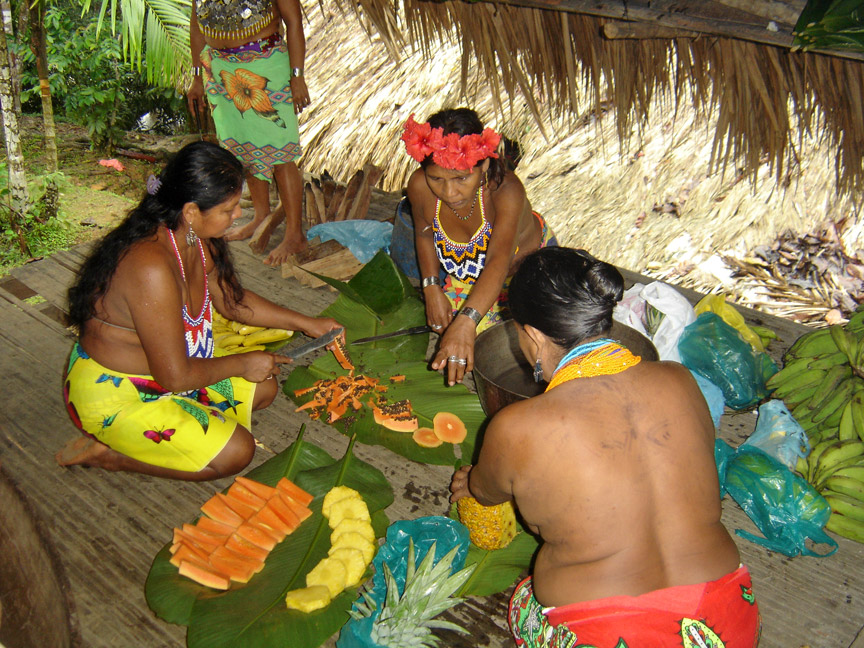
Their government is political and administrative, with General Chiefs as maximum
authority and sahilas for each village.
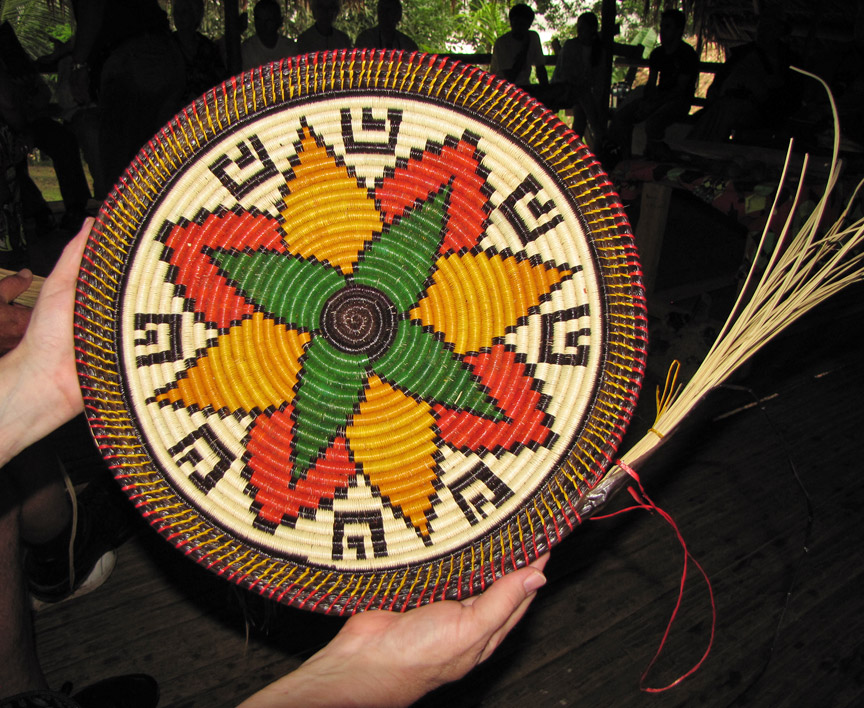
Waounan people are famous crafters. It is believed that they were the original
basket weavers and wood carvers of the region. Today most indigenous groups
produce versions of their canastas and cocobolo carvings. The Embera people have
adopted the techniques and have expert artists of their own.
Text from Wikipedia
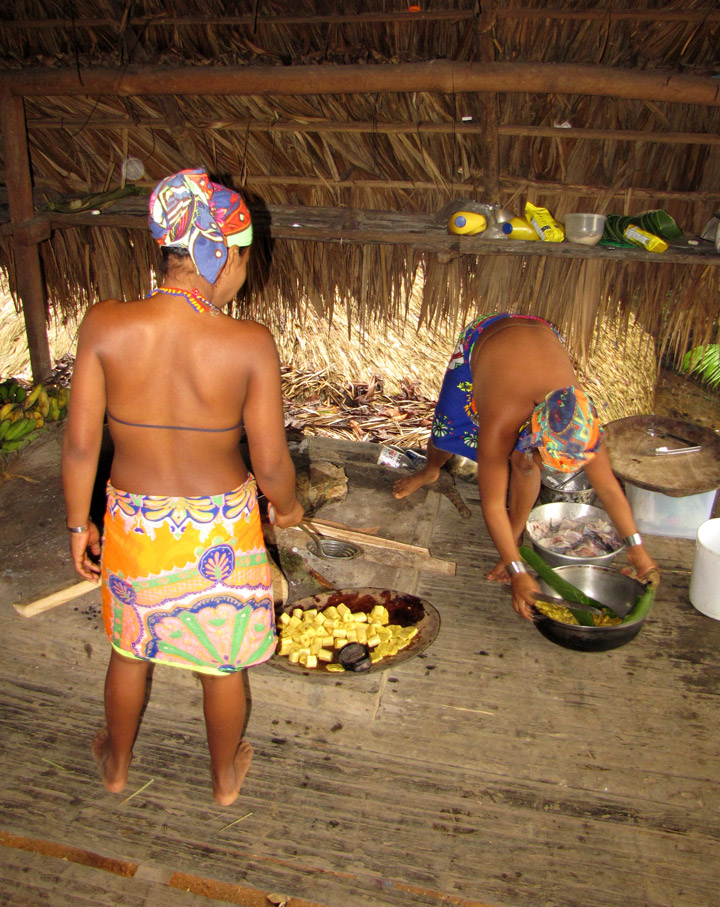
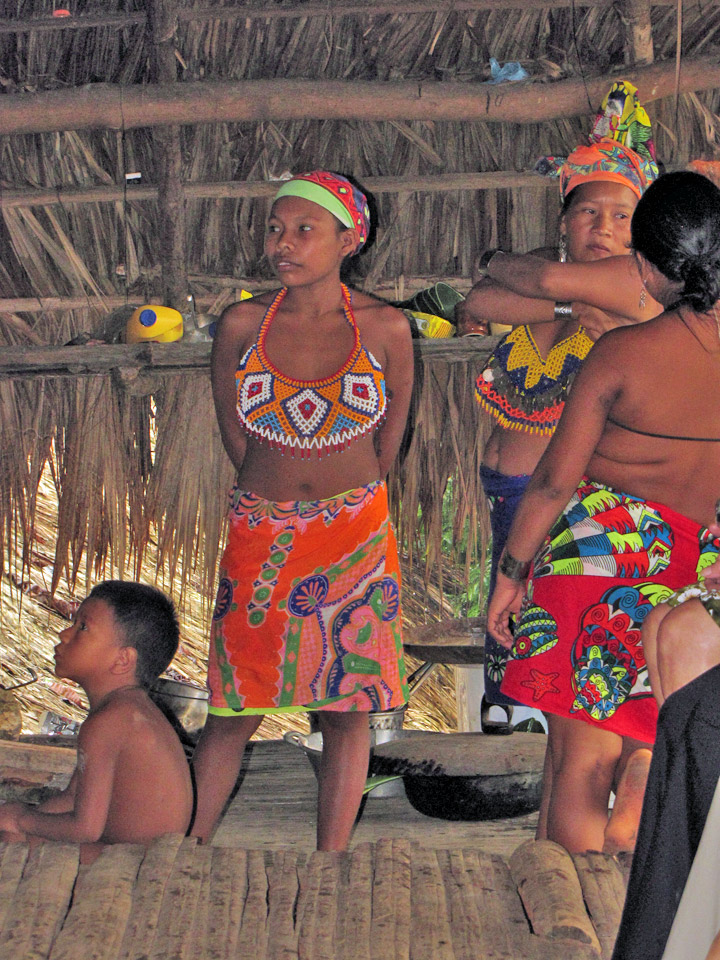
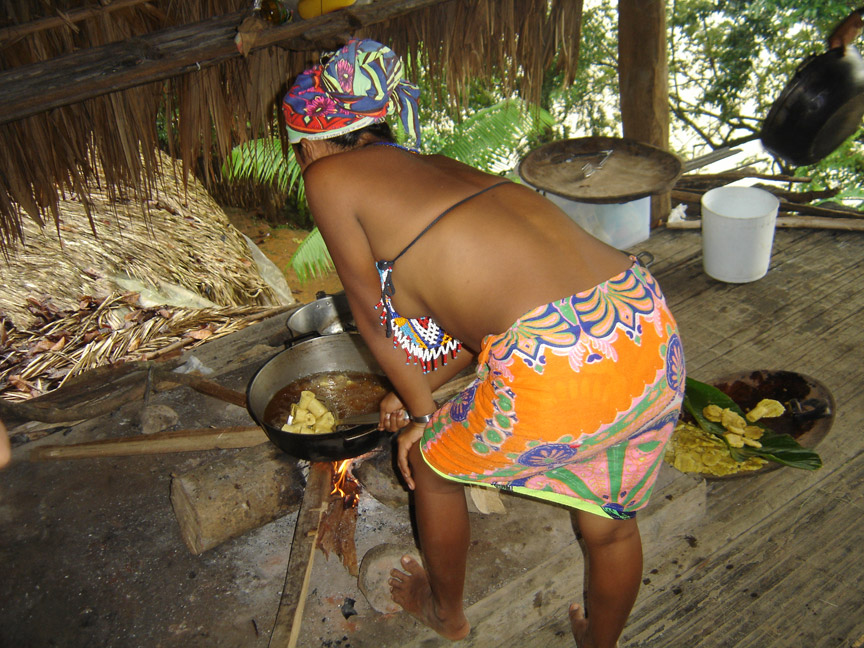

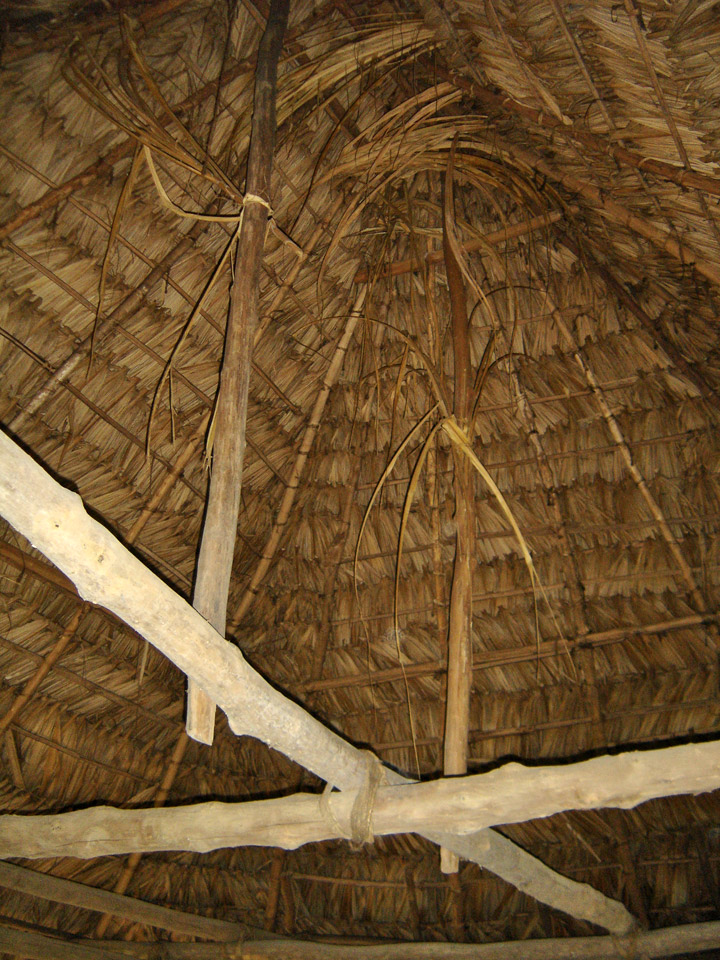
roof interior

in the rain

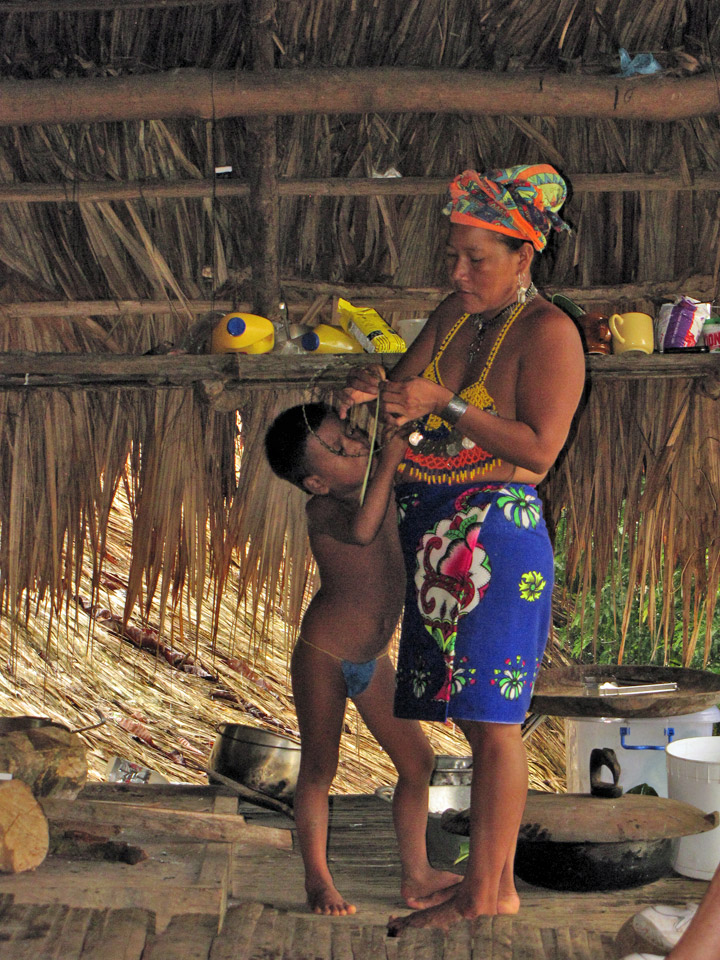
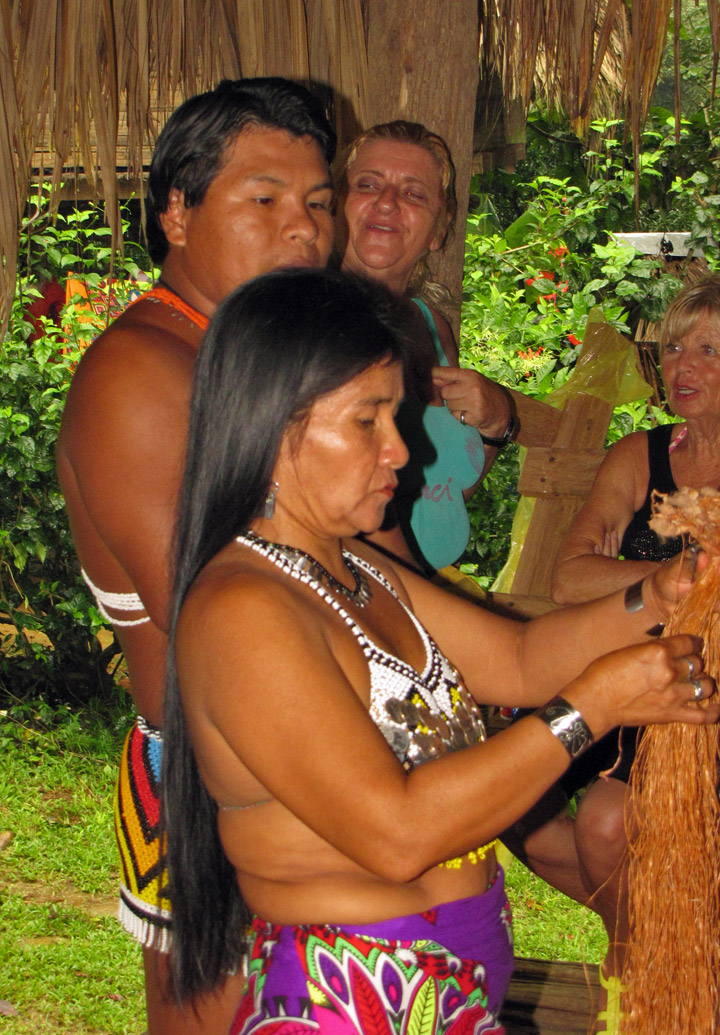

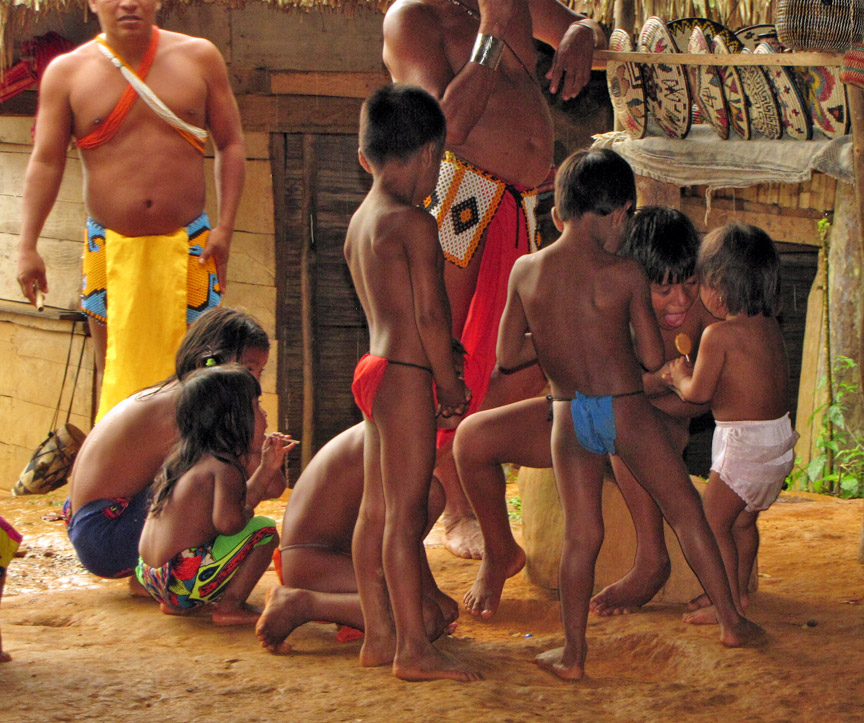
sharing a gift

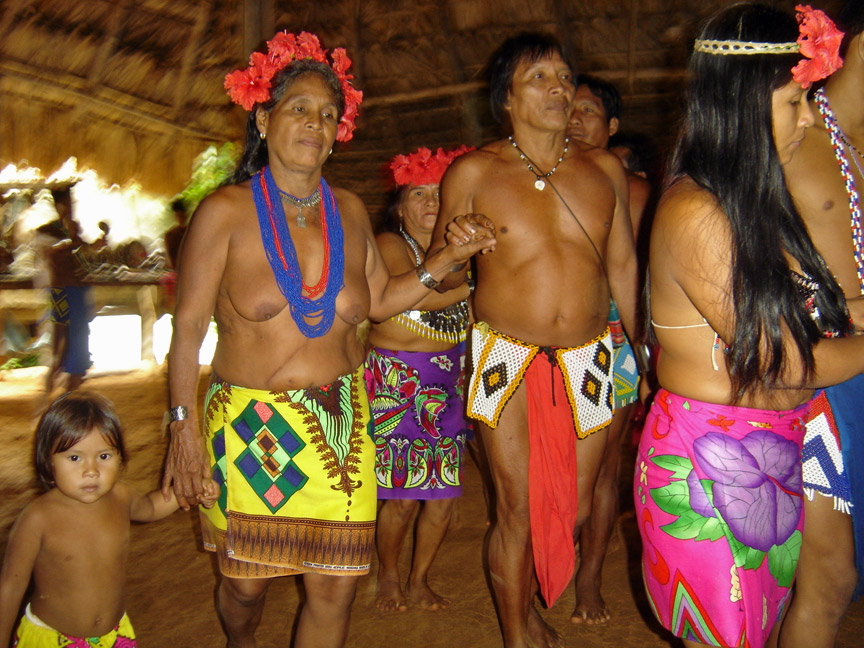
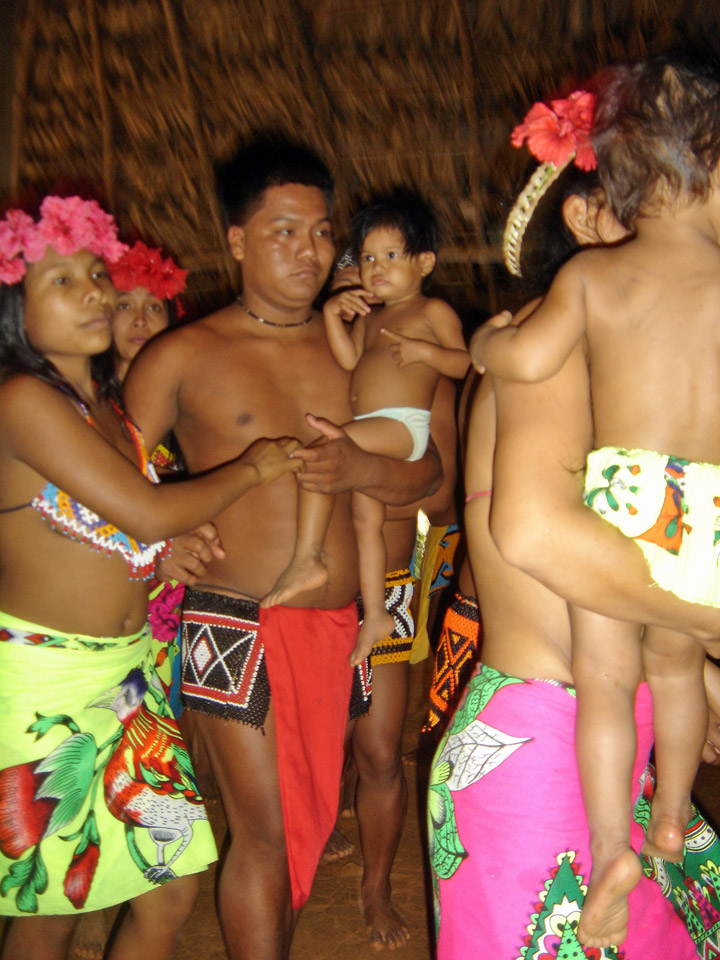
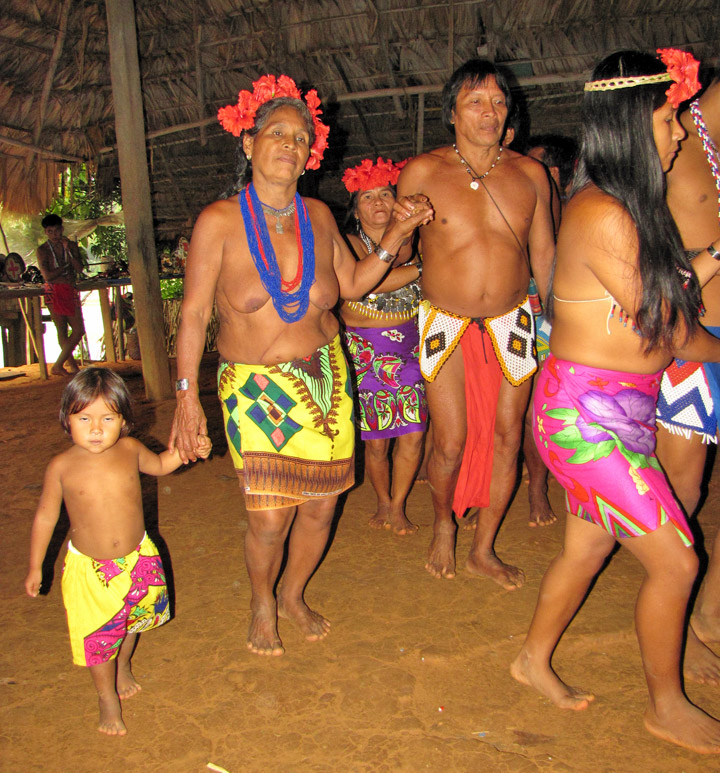
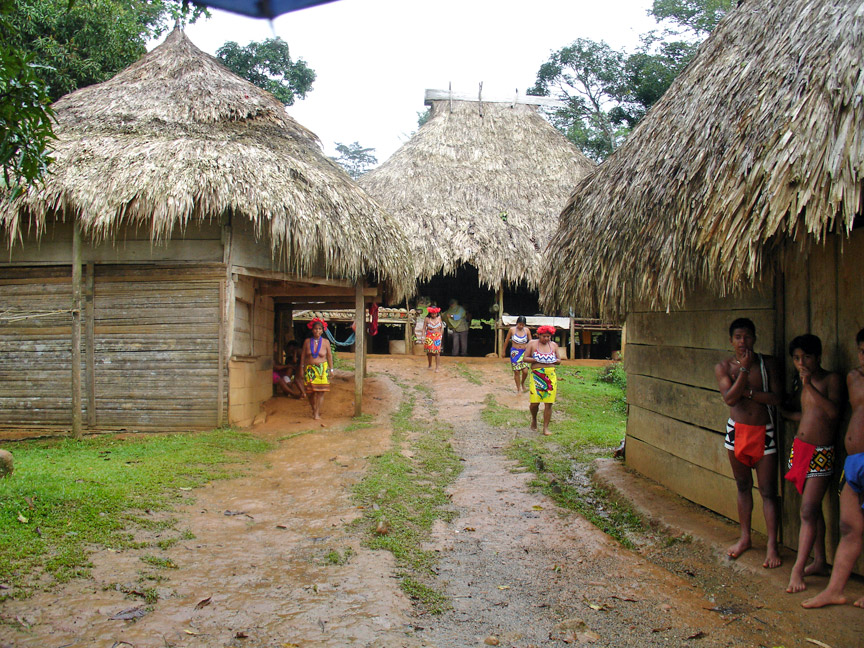
leaving the village
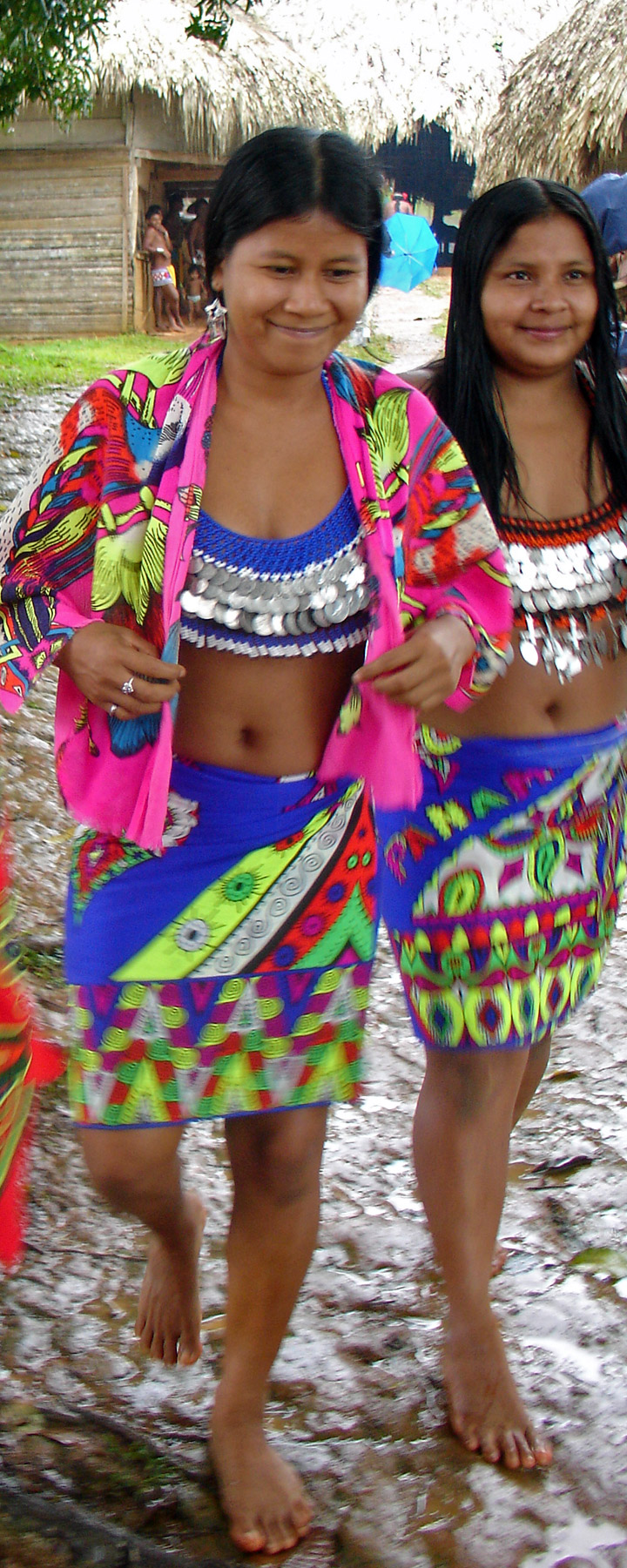
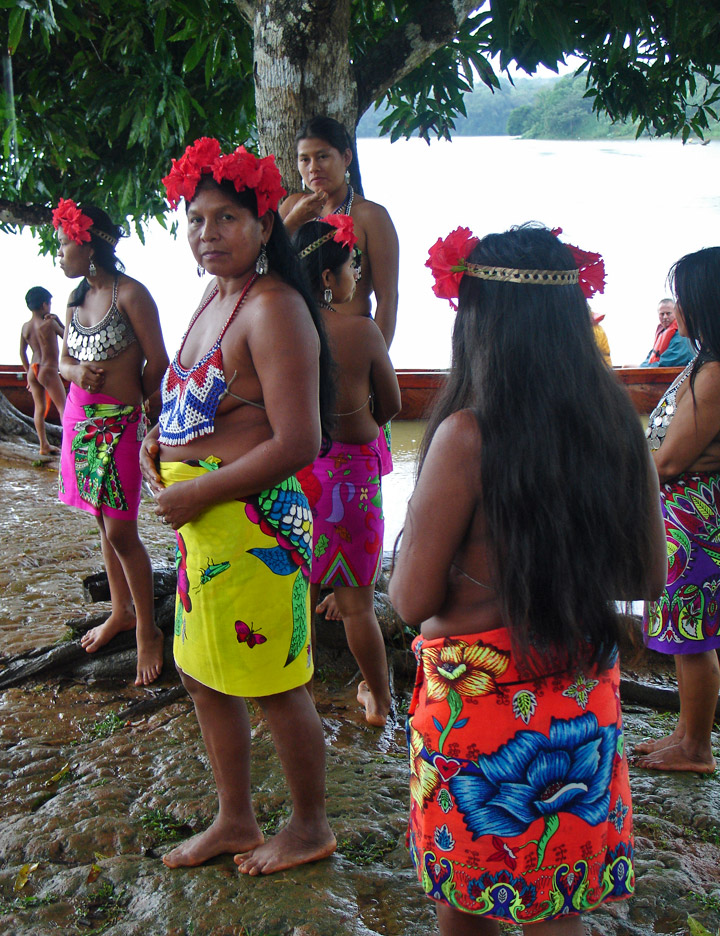
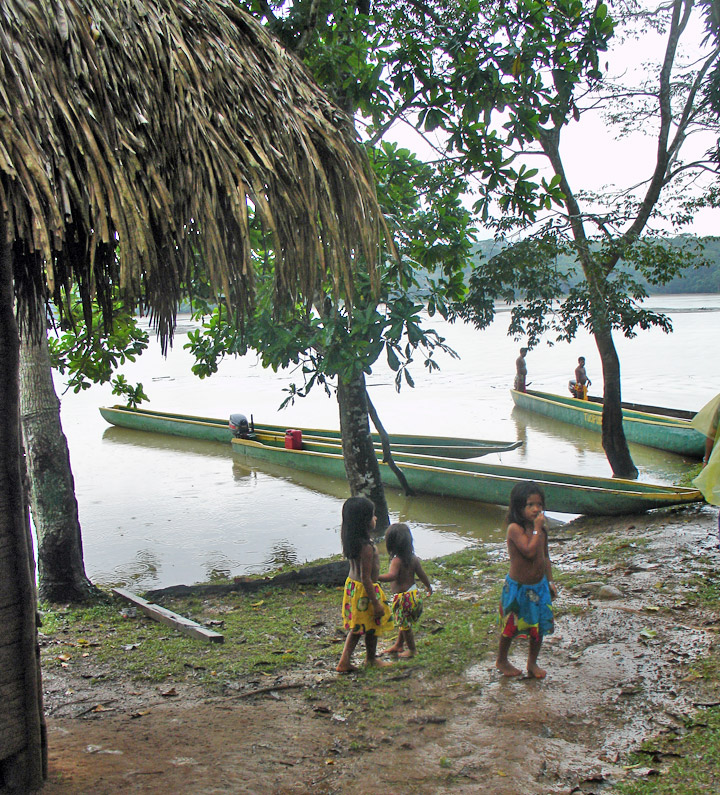
the canoes
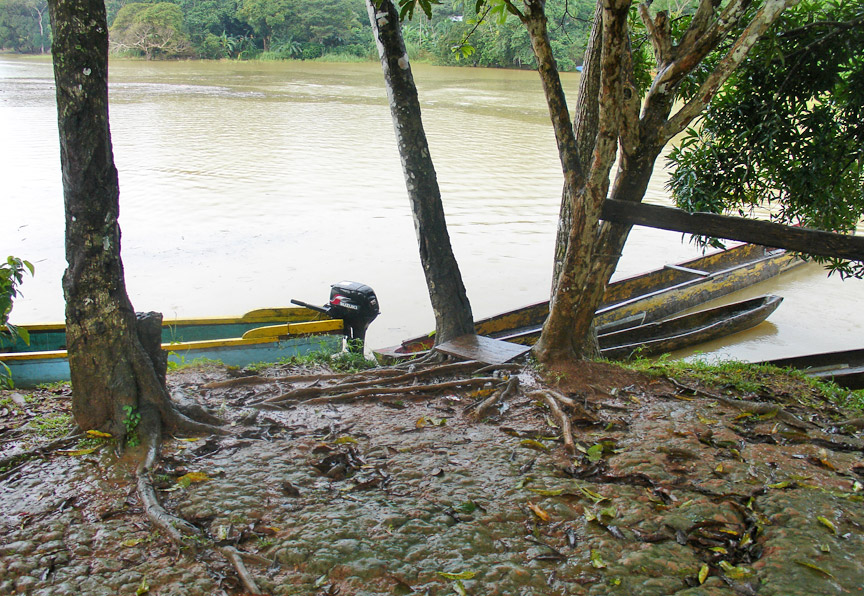
each with an outboard engine
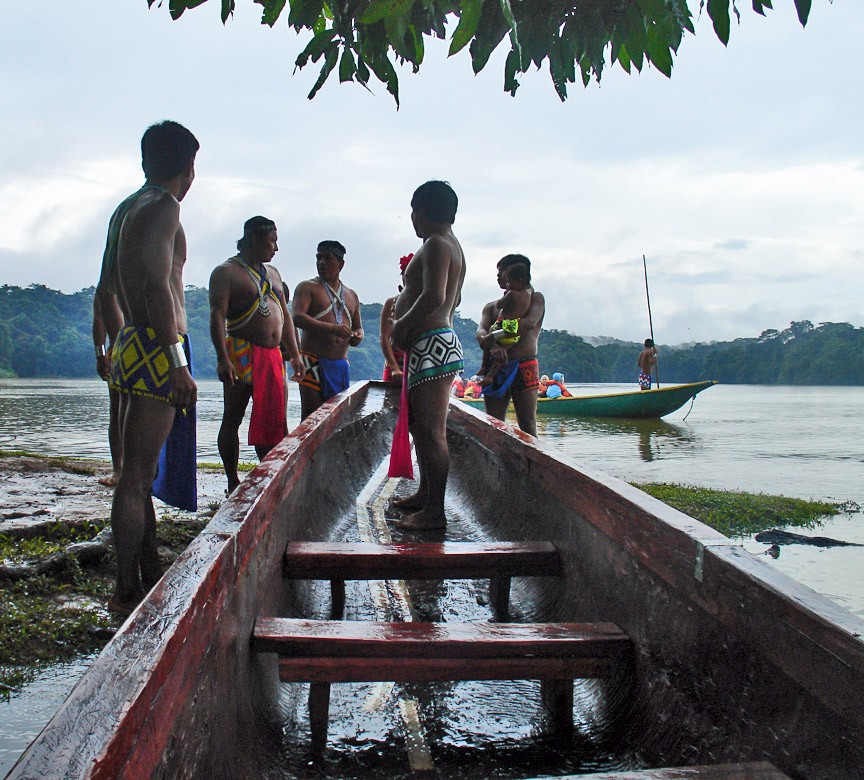
their handicraft
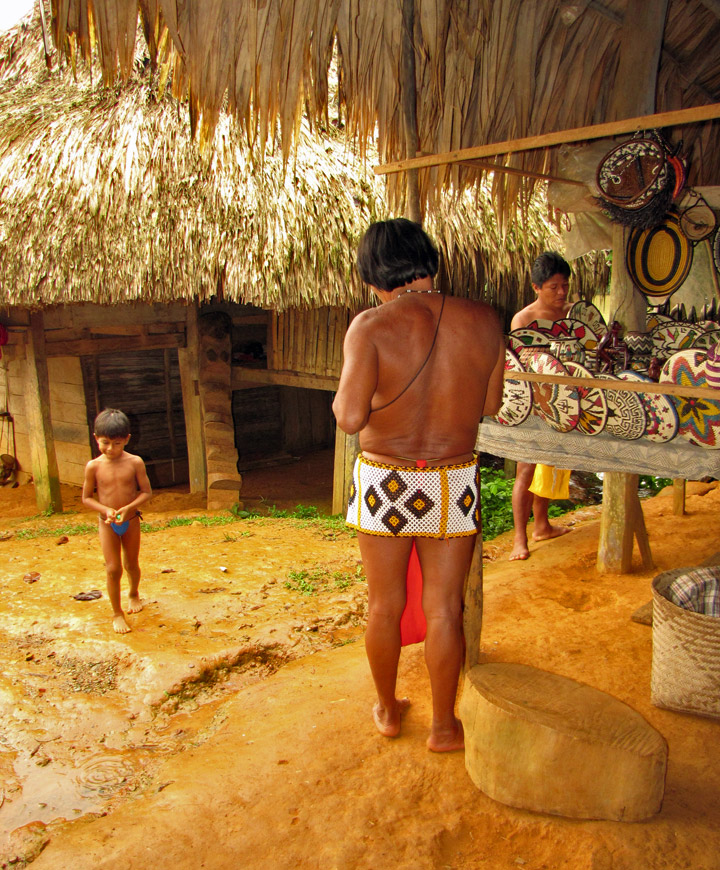
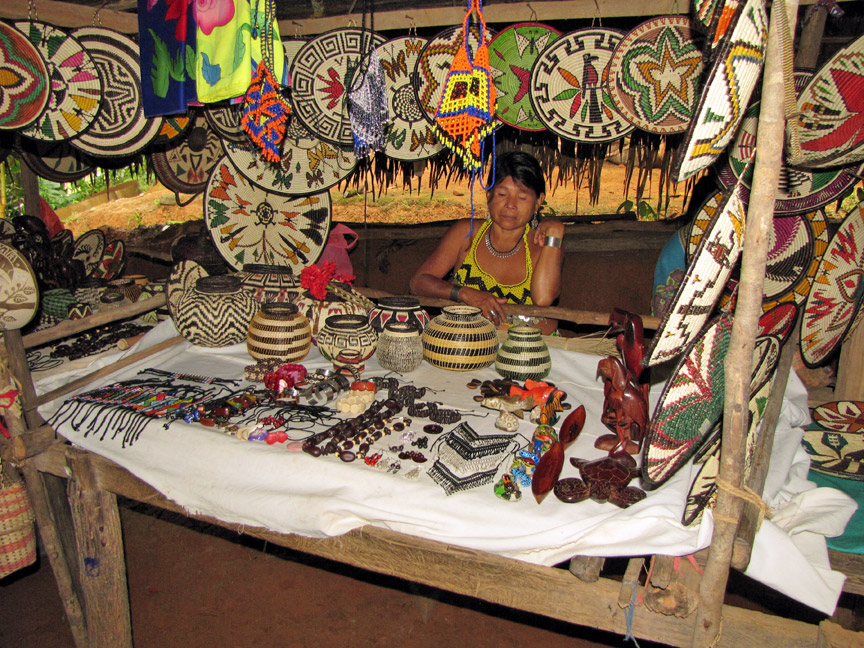
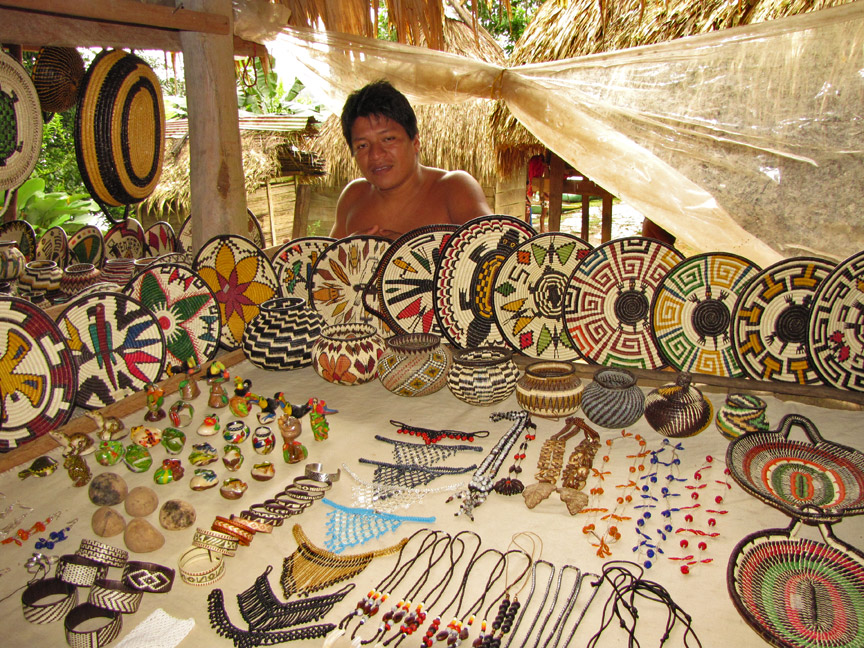
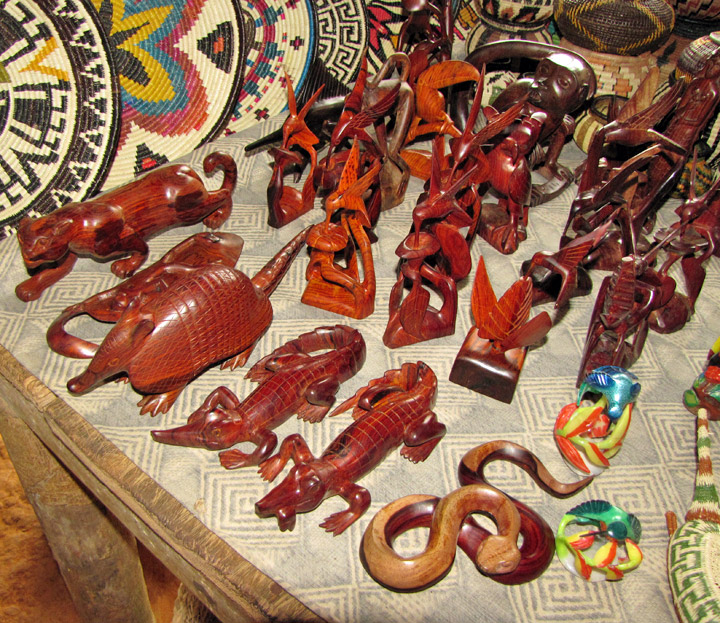
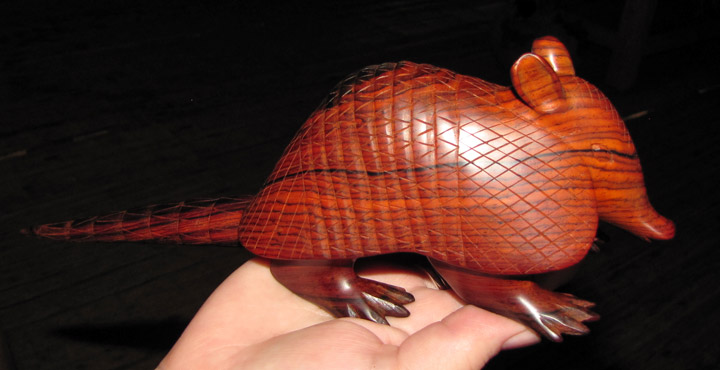
the armadillo